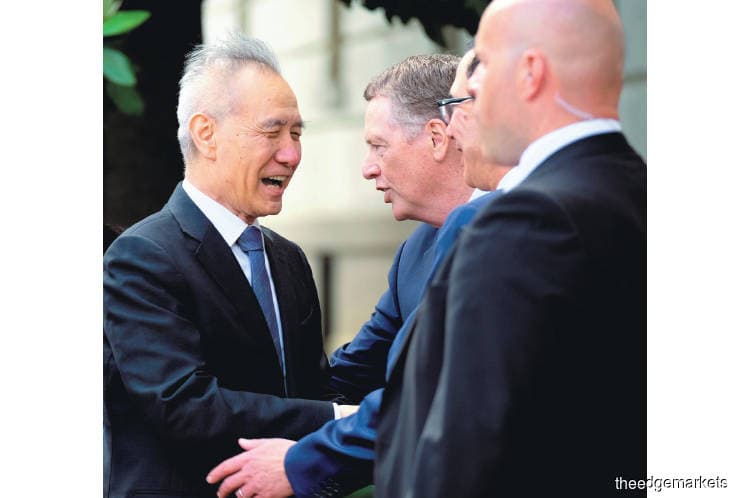
This article first appeared in The Edge Malaysia Weekly on May 13, 2019 - May 19, 2019
THIS week’s overnight policy rate (OPR) cut of 25 basis points by Bank Negara Malaysia met the expectations of most economists as concerns over stalling growth rise.
The rate cut is an indication of moderating growth, with the central bank’s move seen by many as a way to stimulate economic activities when borrowing becomes slightly cheaper for corporations and individuals.
Even so, US President Donald Trump appears to have further muddied the waters of global trade last week by imposing a 25% tariff hike on US$200 billion (RM832.24 billion) worth of Chinese imports. For Malaysia, this could negate the many benefits of the OPR cut.
The main concern was that if the talks fail, the US will impose more tariffs on the remaining imports from China, or a US$290 billion worth.
“A further deterioration in trade tensions will risk derailing the expected pickup in the global economy in the second half of the year. Global central banks will likely cut interest rates, especially the US Federal Reserves, to stem the US economy from slowing down sharply,” Socio-economic Research Centre executive director Lee Heng Guie says.
In the Asean region, Malaysia was noticeably the first to cut its key rate, but it was second in Asia after India. After Malaysia’s OPR rate reduction to 3% from 3.25% on May 7, the Philippines followed suit on May 9 by paring its benchmark rate to 4.5% from 4.75%.
In a report, MIDF Research economist Dr Kamaruddin Mohd Nor said Bank Negara’s rate reduction should bring about improvement in investment and domestic consumption activities in the second half of the year.
However, Lee cautions that monetary policy alone will not support the economy.
“It must be complemented by a mix of supportive fiscal and growth policies. These include the ongoing construction of public transportation projects (LRT3 and MRT2), accelerated disbursement of the Budget’s development expenditure as well as the revived East Coast Rail Link (ECRL) and Bandar Malaysia.
“With a still-supportive environment for consumption, the quantum of rate cuts is deemed sufficient to provide some support to consumer spending — although there will be some lag time to its impact — along with continued wage growth, cost of living aid, a stable labour market, stable fuel prices and subdued inflation,” he says.
Lee expects the domestic economy to bottom out in the second quarter. Thereafter, it will moderately improve in the year’s second half, assuming that the global economy will pick up due to more growth-friendly policies adopted by central banks.
However, the ongoing trade tension between the US and China could throw a spanner in the works of improving global economic growth.
The two economic superpowers were expected to resume another day of negotiations on May 10. There was still hope that the US and China could end the week with an agreeable deal, though many believe the risk of it falling through has increased.
In a scenario where the remaining Chinese imports are also slapped with tariffs and European auto imports suffer the same fate, US gross domestic product (GDP) growth will fall into negative territory, notes Deutsche Bank.
Subsequently, the eurozone will fall into a recession while China would also see slower growth, which will severely impact Asian economies, it bank adds.
“Initially, slower export growth would likely be combined with a withdrawal of foreign portfolio capital, putting downward pressure on currency exchange rates to the dollar. But weaker currencies would depress import demand over and above the decline in imports stemming from the contraction of export-oriented activities.
“The current account balances would start rising, which will eventually end the sell-off in Asian currencies. Countries entering this scenario with current account deficits may take longer to stabilise and may need to raise interest rates to help this process along,” it explains.
Like SERC’s Lee, Deutsche Bank expects the Fed to cut interest rates in a full-blown trade war scenario. It adds that most economies will introduce monetary stimulus measures, as the Fed cut rates to zero and possibly resume quantitative easing.
That said, the basis for economists is that the two parties will reach some kind of resolution this year.
For now, they are not expecting to see another rate cut for this year. AmBank Research believes the likelihood of a rate cut will depend on the severity of the downside risks to growth and whether there is evidence of tightening financial conditions after the latest cut.
Lee says the 25bps cut is expected to be a one-off policy rate easing as Bank Negara would reserve its monetary arsenal for future economic shocks.
“While the domestic economy is slowing, it is not in (such) dire straits to warrant a big dose of monetary easing. Bank Negara has many policy tools to choose from before wielding blunt instruments such as interest rate cuts. These include reduction in the statutory reserve requirement to boost credit growth and reduce firms’ borrowing costs,” he says.
Save by subscribing to us for your print and/or digital copy.
P/S: The Edge is also available on Apple's AppStore and Androids' Google Play.